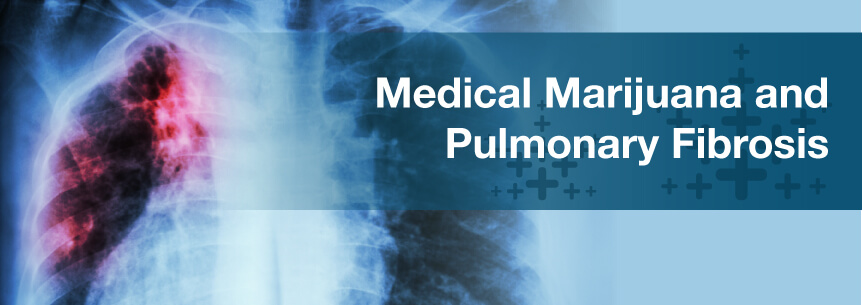
Medical cannabis is becoming more and more popular as a potential medical treatment for a variety of chronic health conditions. Medical marijuana for pulmonary fibrosis could offer relief as well.
Because there’s inflammation involved with pulmonary fibrosis, anti-inflammatory medications and treatments are usually effective. In one study, researchers found the THC in marijuana to have anti-inflammatory properties, which they feel accounts for the pulmonary function improvement in patients using cannabis.
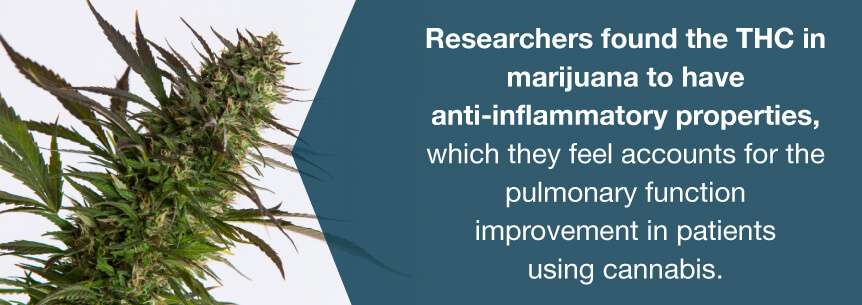
Ingested or vaporized weed may offer potential benefits due to its immunosuppressant, anti-inflammatory and bronchodilation (airway-opening) properties.
Find A Doctor Find A Dispensary
In the 1970s, Donald Tashkin at the University of California Los Angeles performed studies that found both orally ingested and inhaled THC provide bronchodilation for several hours after it’s administered. Other studies found activating the CB1 receptor inhibits smooth muscle contraction of the lungs, which offers a potential acute bronchodilation mechanism linked with marijuana intake.
Cannabinoids provide anti-inflammatory qualities. Raw plant acidic cannabinoids (CBDA, THCA, etc.) provide greater anti-inflammatory properties than the raw plant’s non-acidic cannabinoids (CBD, THC, etc.). Researchers have found CBD to improve COPD symptoms. It also acts as an inflammatory agent and leads to reduced pulmonary inflammation and improved lung function in mice with inflammatory lung disease.
In addition to the anti-inflammatory benefits of marijuana for pulmonary fibrosis, the herb may also have an anti-anxiety effect. A researcher who performed clinical studies reports patients feeling relaxed and calm after using cannabis.
Studies like these show that marijuana may act as a way to reduce acute airway constriction attacks and become a viable preventative therapy for COPD patients. However, researchers need human trials to confirm these benefits.
According to the Lung Institute, marijuana and pulmonary fibrosis treatment could also help in:
Just note that smoking cannabis presents one possible problem when using medical marijuana to treat pulmonary fibrosis. Smoking weed may harm patients with lung diseases, since there’s no “filter” on a joint or marijuana cigarette and individuals smoking it tend to inhale its smoke more deeply. This leaves smoke in their lungs for a more extended period than cigarettes.
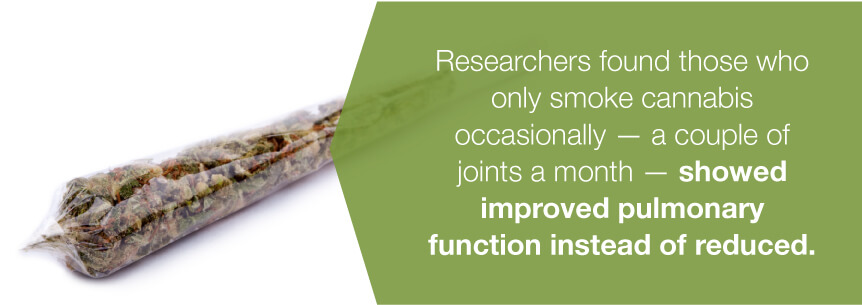
Still, researchers found those who only smoke cannabis occasionally — a couple of joints a month — showed improved pulmonary function instead of reduced.
As with any treatment, finding the right medical cannabis strain for pulmonary fibrosis may take some trial and error. Just like not every treatment may be effective for your symptoms, not all strains will be, either. To help with this, below are some strains that are good for relieving the symptoms of pulmonary fibrosis:
For Inflammation:
For Sleep:
For Pain:
For Depression:
Medical marijuana may also help alleviate the uncomfortable side effects of some of the medications used for pulmonary fibrosis, such as nausea and vomiting, headache, anxiety and more. For instance, Headband is good for nausea, Sour Diesel for a headache and Jack Herer for anxiety.
The benefit of cannabis and pulmonary fibrosis treatment, when compared with standard treatments, is the flexibility in delivery. These days, you can ingest cannabis in multiple ways, including:
CBD oil eliminates the THC chemical so you don’t get that “high” feeling — only relief from your symptoms.
Pulmonary fibrosis, like any other condition, can be distressing. But you can find some relief from its uncomfortable symptoms. Search for a medical marijuana doctor today so you can obtain your medical marijuana card and begin shopping around for your perfect strains by finding a cannabis dispensary. Once you book an appointment with a licensed cannabis doctor, you’ll be well on your way to experiencing the benefits medical marijuana can offer you.
Find A Doctor Find A Dispensary
Pulmonary fibrosis (PF) is a health disorder that causes lung stiffness and scarring, making it hard to breathe. It may keep your body from getting the oxygen you need and can eventually result in heart failure, respiratory failure and other problems. Doctors and researchers discovered the first form of lung fibrosis during the 19th century. During this time, they took lung samples to try to understand the reason behind the scarring. PF didn’t show much improvement until the 20th century.
There’s no scarring in normal lungs — that means oxygen passes from the lungs easily and into the air sacs and bloodstream. This oxygenates the blood. With pulmonary fibrosis, your lungs don’t have elasticity and are stiff because of the scarring. The scarring makes it difficult for the oxygen to move around the air sacs, or alveoli, and reduces how much oxygen passes into your bloodstream.
The fibrosis also reduces the size of your lungs over time, which further worsens the condition. As your pulmonary fibrosis progresses, it may get harder and harder for you to breathe and you may need to rely on an oxygen device to help you.
A variety of factors can cause pulmonary fibrosis-related scarring. However, in most instances, physicians can’t figure out exactly what the cause of it is. When this occurs, it’s known as idiopathic pulmonary fibrosis. Researchers think a combination of lung irritant exposure and other factors may play a significant role in the condition. These may include:
Scientists used to think inflammation caused pulmonary fibrosis. Now, they believe an irregular lung healing process could lead to scarring. Significant lung scarring formation eventually turns into pulmonary fibrosis.
There are two types of pulmonary fibrosis:
When doctors can’t confirm the cause of the condition, they term it “idiopathic.” Since they don’t know what the disease’s underlying cause is, it can be hard for them to treat it. At present, there are a couple of medications the Food and Drug Administration (FDA) has approved to treat idiopathic pulmonary fibrosis (IPF). These are Ofev and Esbriet. They help slow the disease’s progression down and avoid exacerbations.
Respiratory failure is a concern for patients with IPF, but the condition may also lead to:
People rarely get familial pulmonary fibrosis. Although it’s just as severe as idiopathic pulmonary fibrosis, doctors can often diagnose it much earlier to give the patient a better outcome. Physicians can also separate both types of pulmonary fibrosis into stages:
Doctors monitor the disease through staging, which helps them advise the patient and family about the progression of their PF, define the outcome and decide on a treatment approach.
Pulmonary fibrosis symptoms may include:
The severity of symptoms and course of pulmonary fibrosis can be considerably different for each person. While some may get sick fast with the condition, others may have moderate discomfort that gradually gets worse with time.
Then, there are those who have their symptoms become rapidly worse. This is called acute exacerbation and might include symptoms like shortness of breath, which could last for several weeks. If you have acute exacerbations, you doctor may place you on a mechanical ventilator. Your physician may also prescribe you corticosteroid medications or antibiotics to treat the acute exacerbation.
Lung scarring associated with pulmonary fibrosis is not reversible. No treatments have proven effective in stopping the disease’s progression entirely, but some treatments might slow the advancement of the disease temporarily and improve symptoms.
Patients with idiopathic pulmonary fibrosis have a median survival rate of only two to three years, but there are those who do live much longer. The most common reason for death with PF is respiratory failure due to the progression of the condition. While there’s an overall poor prognosis for IPF, the clinical course of each patient differs from gradual progression of the condition to acute decompensation and death.
Several clinical variables associate with survival, but there’s no real approach to bring predictors together to define the disease’s stage or determine prognosis accurately.
When thinking of a person with lung disease like idiopathic pulmonary fibrosis, you can probably understand why a primary side effect would be physical exhaustion. However, what you may not realize is that mental exhaustion typically coincides with having chronic conditions like IPF.
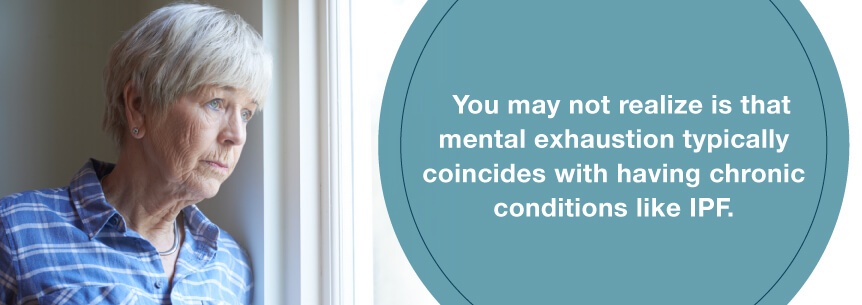
Pulmonary fibrosis can make you feel mentally exhausted on top of taking a physical toll on your body. Asking for help can be difficult for you. Because of your declining lung function, you likely can’t do simple things like you once could. While your loved ones might offer you help, it may be a mental battle internally for you to accept it or ask for it.
You also need to consider your future needs. There will be things to think about such as:
It all can become overwhelming. You may be worried about what your condition will do to your family and what it will put them through. Numerous things can cause mental exhaustion and fatigue relating directly to your IPF diagnosis and living with the condition.
There’s also the risk of depression and anxiety. In a study, anxiety and depression symptoms were seen in around 25.9 percent and 21.4 percent of IPF patients. Anxiety and depression are quite common in idiopathic pulmonary fibrosis patients. While there are no substantial differences as far as hospitalization and survival rate, this study shows anxiety and depression can influence an idiopathic pulmonary fibrosis patient’s quality of life significantly.
Statistics reported by the National Institutes of Health about pulmonary fibrosis include:
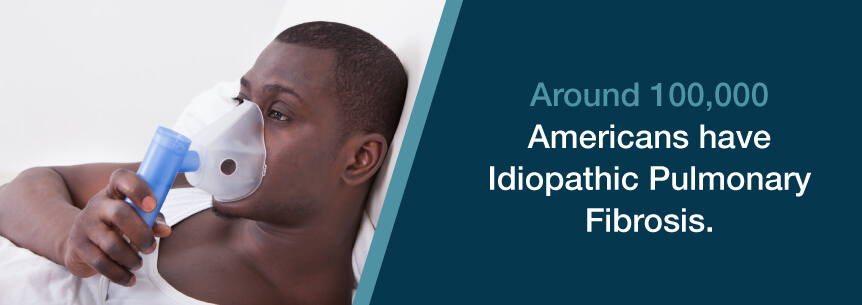
Each person who receives a pulmonary fibrosis diagnosis will experience the condition in their own way. There isn’t any expected or standard clinical course.
Some individuals remain stable for long periods of time while others experience a quick symptom progression. There are then those who suffer episodes of deterioration as time goes on that fluctuate between periods of worsening symptoms and stability. Because of this, doctors individualize PF treatment approaches based on medical history and symptoms.
Doctors prescribe a whole range of PF medications. Your doctor decides if you require medication to treat your pulmonary fibrosis case. Some medications your doctor could prescribe to treat your pulmonary fibrosis include:
Corticosteroids like prednisone decrease inflammation and suppress your immune system. Side effects may include:
Cytoxan is a chemo agent that suppresses inflammation. Doctors commonly prescribe it to treat different types of PF. While patients usually take cyclophosphamide in pill form, you can receive it intravenously. Side effects may include:
Myfortic and Cellcept are two types of mycophenolate mofetil medications. They modulate your immune system. Doctors may prescribe them by themselves or with corticosteroids. Side effects may include:
This is an anti-fibrotic that doctors use to treat IPF. It helps slow lung function decline in those who have mild-to-moderate cases of idiopathic pulmonary fibrosis. You take it twice a day orally. Side effects may include:
These are only some of the many different medications prescribed to patients with pulmonary fibrosis. Be sure to talk with your doctor to see which of these or other medicines might help treat your PF.
The medical research community continues to aggressively investigate new treatments for all types of pulmonary fibrosis. You can reach out to your doctor to see if you can join a study testing experimental treatment options. Clinical trials for pulmonary fibrosis can include studies of anti-fibrotic therapies, stem cell therapies, growth factor inhibitor proteins and genetic research.
You can search for clinical trials for pulmonary fibrosis at the National Institutes of Health (NIH) website.